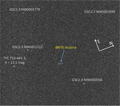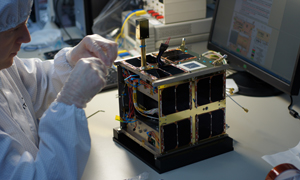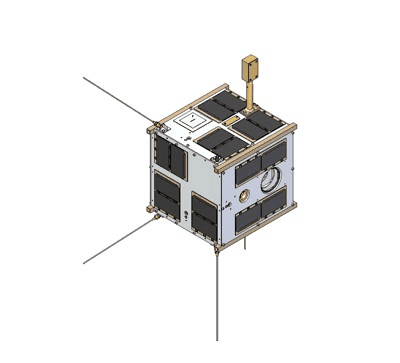

![]() Brite-Austria has been observed on the images from the PST2 telecscope located in Winer Observatory in Arizona. The animation shows a sequence of 20 images of a small field in Orion. BRITE-Austria passes the field in images from 8th to 12th. The images were captured with the Andor iXon X3 EMCCD
camera attached to the PST2 70-cm telescope, the exposure time was only 0.02s. Animation courtesy Krzysztof Kamiński from Poznań Observatory.
Brite-Austria has been observed on the images from the PST2 telecscope located in Winer Observatory in Arizona. The animation shows a sequence of 20 images of a small field in Orion. BRITE-Austria passes the field in images from 8th to 12th. The images were captured with the Andor iXon X3 EMCCD
camera attached to the PST2 70-cm telescope, the exposure time was only 0.02s. Animation courtesy Krzysztof Kamiński from Poznań Observatory.
![]() In late 2016/early 2017 several new publications related to BRITE have
appeared. H. Pablo et al. The BRITE Constellation Nanosatellite Mission: Testing, Commissioning, and Operations describe the testing, commissioning and operations of the BRITE satellites. In particular, they show how unexpected technical problems related to high-energy cosmic radiation were mitigated.
In late 2016/early 2017 several new publications related to BRITE have
appeared. H. Pablo et al. The BRITE Constellation Nanosatellite Mission: Testing, Commissioning, and Operations describe the testing, commissioning and operations of the BRITE satellites. In particular, they show how unexpected technical problems related to high-energy cosmic radiation were mitigated.
![]() The first three scientific papers presenting results of the BRITE satellite mission have been published in the April 2016 issue of Astronomy & Astrophysics. The BRITE mission consists of six nanosatellites of which two, Lem and Heweliusz, are the first Polish scientific satellites.
The first three scientific papers presenting results of the BRITE satellite mission have been published in the April 2016 issue of Astronomy & Astrophysics. The BRITE mission consists of six nanosatellites of which two, Lem and Heweliusz, are the first Polish scientific satellites.
The papers are devoted to four bright stars of the southern sky located in the second stellar field observed by BRITE, the Centaurus field. These are alfa Circini, beta, eta and mi Centauri. alfa Circini is a rapidly oscillating Ap star, the brightest representative of this interesting class of pulsating stars having strong magneting fields and explained by the model of oblique rotator. With BRITE data, two known pulsation modes were confirmed, but for the first time it was shown that rotational variability is different in blue and red passbands. (Weiss et al., A&A 588, A54: The roAp star alfa Circinus as seen by BRITE-Constellation).

![]() Happy Birthday for Lem!
Happy Birthday for Lem!
On 21 November 2015, the first Polish scientific satellite BRITE-PL "Lem" celebrated its second year of operation in orbit. Within these years the spacecraft has completed 10540 orbits around the Earth and has travelled over 460 million kilometers since its launch. "Lem" operates as planned and performs a regular research and observations according to the BRITE mission plan. The photo on the left presents the part of sky with Orion constellation captured by the satellite's telescope, the Pleiades star cluster is shown on the part of the enlarged image.
![]() On 19 August 2014 the second Polish scientific satellite BRITE-PL "Heweliusz" was launched at 3:15:00 UTC (at 5:15:00 CET) by a Chinese Long March-4B rocket from the launch complex of Taiyuan Satellite Launch Center, 600 km on south-west from Beijing.
On 19 August 2014 the second Polish scientific satellite BRITE-PL "Heweliusz" was launched at 3:15:00 UTC (at 5:15:00 CET) by a Chinese Long March-4B rocket from the launch complex of Taiyuan Satellite Launch Center, 600 km on south-west from Beijing.
The first connection to "Heweliusz" was established at 10:02 am during the first pass of the satellite over Europe. The first signal from "Heweliusz" was received, which was quite strong and stable. Communication in both directions (up and downlink) was fine, practically without any downtime and delays. The House Keeping onboard computer (HKC) was switched on and housekeeping data was received. All the main operating parameters are OK.

![]() On 21 November 2013 at 7:10:11 UTC time (8:10:11 CEST -Central European time CET) Russian Dnepr rocket RS-20 reached low Earth orbit with the First Polish Scientific Satellite BRITE-PL "Lem". Dnepr rocket was launched from an underground silo in Yasny military base in the Southern Urals.
On 21 November 2013 at 7:10:11 UTC time (8:10:11 CEST -Central European time CET) Russian Dnepr rocket RS-20 reached low Earth orbit with the First Polish Scientific Satellite BRITE-PL "Lem". Dnepr rocket was launched from an underground silo in Yasny military base in the Southern Urals.
One hour and 38 minutes after the launch of the Dnepr rocket, during the first pass of the satellite over Europe, the connection to "Lem" was established. Now regular communication with is taking place during morning and evening passes. The functional tests of "Lem" are performed in orbit. The satellite operates according to the plan.
![]() The satellite "Heweliusz" has been already assembled and it passed the final part of tests before launch. In October 2013 it passed the vibration tests in DLR laboratory in Berlin.
The satellite "Heweliusz" has been already assembled and it passed the final part of tests before launch. In October 2013 it passed the vibration tests in DLR laboratory in Berlin.
![]() The First Polish Scientific Satellite "Lem" has finished its last tests in clean-room in the Centrum Badań Kosmicznych and it has started its journey to Yasny launch base in Russia leaving the CBK on 23 September 2013. In October/November the satellite was being prepared for installation on the Dniepr rocket and it passed final tests. Engineers from the CBK and SFL worked on readying "Lem for launch".
The First Polish Scientific Satellite "Lem" has finished its last tests in clean-room in the Centrum Badań Kosmicznych and it has started its journey to Yasny launch base in Russia leaving the CBK on 23 September 2013. In October/November the satellite was being prepared for installation on the Dniepr rocket and it passed final tests. Engineers from the CBK and SFL worked on readying "Lem for launch".
![]() The first satellite "Lem" is already assembled and ready for lift-off to its orbit. It is placed in the clean-room in Centrum Badań Kosmicznych, where it passes the functional tests. Soon the "open-field" tests and scietific software verification will be performed as well.
The first satellite "Lem" is already assembled and ready for lift-off to its orbit. It is placed in the clean-room in Centrum Badań Kosmicznych, where it passes the functional tests. Soon the "open-field" tests and scietific software verification will be performed as well.

![]() The ceremony to give the name "Heweliusz" to the First Polish Scientific Satellite took place on 21 April 2012 in SRC. The winners of the contest "BRITE-PL the First Polish Scientific Satellite" are the Godparents of the satellite. The honorary patronage over the contest was held by The Minister of National Education.
The ceremony to give the name "Heweliusz" to the First Polish Scientific Satellite took place on 21 April 2012 in SRC. The winners of the contest "BRITE-PL the First Polish Scientific Satellite" are the Godparents of the satellite. The honorary patronage over the contest was held by The Minister of National Education.

![]() The first Polish scientific satellite Brite-PL 1 ("Lem") has been successfully integrated on 24 November 2011 in the afternoon. It appeared in the whole breathtaking beauties on the laboratory table in the clean-room at SRC Warsaw after 2-weeks of assembling.
The first Polish scientific satellite Brite-PL 1 ("Lem") has been successfully integrated on 24 November 2011 in the afternoon. It appeared in the whole breathtaking beauties on the laboratory table in the clean-room at SRC Warsaw after 2-weeks of assembling.
On the left there is the first photo of the integrated satellite Lem. More photos from the integration process are in gallery on the Brite-pl's site. The movies presenting the satellite integration are also available.
![]() The official opening of the ground station for communication with satellites of BRITE's constellation took place in Warsaw on 6 December 2011.
The Operation of station has been demonstrated through the receipt of telemetric transmission from stratospheric balloon Bobas NG, which was launched from IMGW Institute in Legionowo near Warsaw. The radio amateurs could get back transmission from balloon as well.
The official opening of the ground station for communication with satellites of BRITE's constellation took place in Warsaw on 6 December 2011.
The Operation of station has been demonstrated through the receipt of telemetric transmission from stratospheric balloon Bobas NG, which was launched from IMGW Institute in Legionowo near Warsaw. The radio amateurs could get back transmission from balloon as well.
![]() Since 2011 the assembling and testing the subsystems of the first satellite has been started. The film about work currently carried out can be found on BRITE-PL website.
Since 2011 the assembling and testing the subsystems of the first satellite has been started. The film about work currently carried out can be found on BRITE-PL website.
![]() Ministry of Science and Higher Education announced the winners for the names of the first two Polish satellites. Lem won Hevelius. Readers and sympathizers of Stanislaw Lem's decided that one of the most popular Polish writers will be the patron of the first Polish satellite Brite-PL. As a name for the second satellite, Internet's users chose the name of famous Gdansk astronomer Hevelius.
Ministry of Science and Higher Education announced the winners for the names of the first two Polish satellites. Lem won Hevelius. Readers and sympathizers of Stanislaw Lem's decided that one of the most popular Polish writers will be the patron of the first Polish satellite Brite-PL. As a name for the second satellite, Internet's users chose the name of famous Gdansk astronomer Hevelius.

![]() BRITE satellites are so-called nanosatellites weighing less than 10 kg. Poland will run the research program with Space Flight Laboratory of the University of Toronto which specializes in developing and manufacturing such small satellites.
BRITE satellites are so-called nanosatellites weighing less than 10 kg. Poland will run the research program with Space Flight Laboratory of the University of Toronto which specializes in developing and manufacturing such small satellites.
![]() more about Brite-pl
more about Brite-pl